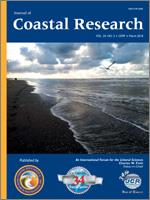Shaeri, S.; Strauss, D.; Etemad-Shahidi, A., and Tomlinson, R., 2018. Hydrosedimentological modelling of a small, trained tidal inlet system, Currumbin Creek, southeast Queensland, Australia.
Small tidal inlets with an entrance width of less than 50 m or a cross-sectional area of less than 100 m2 have not been investigated as often as their larger counterparts. To discern the major processes responsible for entrance infilling in a small inlet system, the hydrosedimentological processes in the annually dredged Currumbin Creek (Australia) inlet system were investigated. Delft3D was applied and validated using local field measurements and regional data. A standalone regional hydrodynamic model and three nested standalone wave models provided detailed data for the offshore boundary of the more detailed creek entrance model, which was a coupled, local flow–wave–sediment transport model. The noncohesive sediment transport module was calibrated based on the volume of dredging and the net annual volume of longshore transport. The results of this hindcast model provided insight into the dominant processes responsible for the inlet's current configuration (i.e. significant refraction of incident waves to a nearly shore normal direction; a noteworthy onshore-offshore transfer of sediments; channel infilling induced by wave-induced currents; very limited sediment transport within the back-barrier lagoon because of an absence of wave-induced currents, as well as weak tide-induced currents; and infilling of the dredged area because of immersed slope stability, rather than hydrodynamic processes). Overall, the adopted modelling approach and the selected model setups proved to be a suitable combination of the available resources and tools to forecast the influence of any alteration to the current maintenance strategy. Accordingly, the identified physical processes and findings can be applied to similar cases with narrow inlet entrance widths and small back barriers with limited circulation.





